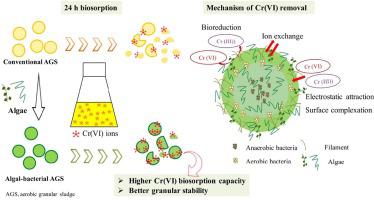Separation and Purification Technology ( IF 8.6 ) Pub Date : 2020-07-02 , DOI: 10.1016/j.seppur.2020.117323 Xiaojing Yang , Ziwen Zhao , Yang Yu , Kazuya Shimizu , Zhenya Zhang , Zhongfang Lei , Duu-Jong Lee

|
Biosorption is considered as a cost-effective and environmentally friendly Cr(VI) removal process from wastewater. This study is the first report on algal-bacterial aerobic granular sludge (AGS) being used as biosorbent for Cr(VI) removal in comparison to conventional bacterial AGS with respect to biosorption performance. Batch tests revealed that Cr(VI) biosorption onto algal-bacterial AGS was highly pH dependent and the maximum Cr(VI) biosorption capacity of 51.0 mg g−1 occurred at pH 2. The Cr(VI) removal by algal-bacterial AGS was found to be accomplished by both biosorption and bioreduction reactions, in which four mechanisms, namely electrostatic interactions, ion exchange, surface complexation and bioreduction were involved. In addition, desorption tests showed that 64–73% of the adsorbed Cr onto the algal-bacterial AGS could be recovered by NaHCO3, and most of the adsorbed Cr was in the form of Cr(III). Compared to the conventional bacterial AGS, algal-bacterial AGS demonstrated higher biosorption capacity and better granular stability, implying that algal-bacterial AGS can be more potentially utilized as a Cr(VI) removal and recovery biomaterial for the treatment of Cr(VI)-containing wastewater.
中文翻译:

使用藻类细菌需氧颗粒污泥增强合成废水中六价铬的生物吸附:批处理实验,动力学和机理
生物吸附被认为是一种经济高效且环保的废水中六价铬去除工艺。这项研究是关于藻类细菌需氧颗粒污泥(AGS)在生物吸附性能方面与传统细菌AGS相比可作为去除Cr(VI)的生物吸附剂的第一份报告。批处理测试表明,藻类AGS对Cr(VI)的生物吸附高度依赖pH值,最大Cr(VI)的生物吸附能力为51.0 mg g -1发生在pH为2时。通过藻类细菌AGS去除Cr(VI)既通过生物吸附反应又通过生物还原反应完成,其中涉及四个机理,即静电相互作用,离子交换,表面络合和生物还原。此外,解吸测试表明,NaHCO 3可以回收藻类AGS上吸附的Cr的64-73%,并且大多数吸附的Cr以Cr(III)的形式存在。与常规细菌AGS相比,藻类细菌AGS具有更高的生物吸附能力和更好的颗粒稳定性,这意味着藻类细菌AGS更有可能被用作Cr(VI)去除和回收生物材料,以处理Cr(VI)-含有废水。


























 京公网安备 11010802027423号
京公网安备 11010802027423号